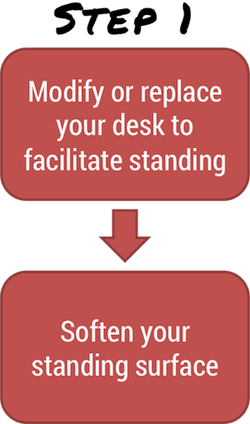
This is the detailed breakout of the Upgrading Your Environment portion of the Quitting Sitting Transition Plan. You can view the main index of the plan here, or have it emailed to you, instantly, in full.
Learning any position, motion, or posture takes time. The body needs to adapt properly and comfortably.
Just like breaking in new running shoes requires time for a successful transition, switching to standing at work should not be an overnight process. You’ll need a transition game plan.
It’s important to first have the proper equipment to help make a successful transition to an upright working posture. Modifying your desk or purchasing a height adjustable desk is the first step, along with making sure your standing surface supports a comfortable standing experience.
Get your custom standing desk measurements, and even free plans to build your own, here.
Consider investing in an anti- fatigue mat, or platform. Next think about your shoes and if they are conducive to the increased time you’ll spend standing.
High heels shorten the achilles tendon and tighten the calves, so they’re not the best choice for increasing your standing time. Instead, try flats, athletic shoes, or even socks. Wearing socks or standing barefoot can allow for a lot of foot and ankle variation as you stand, thus making it more comfortable to stand for longer periods.
Tip: Keep two alternate pairs of shoes at your desk and switch between them 1-2 times per day to avoid foot and ankle fatigue.
Ergonomic positioning is important as you set up your standing workstation. The top 1/3 of the monitor should be at eye level with a 20 degree upwards tilt. The monitor should be approximately arm distance from your body. Your elbows should be open – beyond 90 degrees – while typing, and if possible the keyboard should have a downward slant of 10-20 degrees. This calculator will give you custom measurements and (optionally) free plans to build your own desk. Consider consulting with an ergonomic specialist to ensure your workstation is fitted properly to your body dimensions.
 Begin by using your standing station incrementally. Then start standing longer and longer. Be sure to listen to your body and sit when you are fatigued. If you experience any discomfort, see the Troubleshooting section at the end of the guide.
Begin by using your standing station incrementally. Then start standing longer and longer. Be sure to listen to your body and sit when you are fatigued. If you experience any discomfort, see the Troubleshooting section at the end of the guide.
Try using your standing station as the “entryway to your desk” starting with the first 15 minutes of the day, then using it 15 minutes before and after lunch, and again for the last 15 minutes of the day.
At first these short periods of 15 minutes will get you ready and excited to continue to use the standing desk. These short standing sessions will add variety and help to keep your mind fresh by varying your posture. Stand for tasks that require alertness and agile variation of tasks, such as phone conversations, preparing for meetings, responding to daily email, and periods requiring frequent walking breaks, such as quick work between back to back meetings.
Tip: Schedule your day to align routine tasks with your standing time.
As you get used to spending more time standing, you will find that some tasks and projects are just better with a standing desk, and others are best performed while sitting. This is exactly how you should use your transition to a standing desk: learn which tasks are more productive and enjoyable while standing, and which are better done while sitting. Use this time to listen to your body; it’s up to you to decide how fast or slow you would like to make this transition.
Tip: Find a balance of sitting/standing to help with productivity by varying your work environment throughout the day to best suit the nature of the task.
Have you experimented with productivity sitting vs standing? Which tasks do you most enjoy to do standing? Let us know in the comments!
Get the full plan, view the plan index, or go on to the detail section of Part 2 – Enhance Your Posture.





[…] Get the full plan, view the plan index, go back to Part 3 or start at Part 1. […]